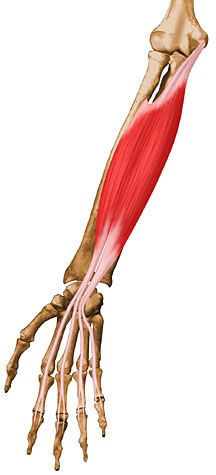
When the Beatles wrote “I Wanna Hold Your Hand” in the coquettish year of 1963 they were not singing about the flexor digitorum superficialis, but this extrinsic flexor muscle, a master puppeteer of the fingers at the proximal interphalangeal joints and crucial in finger muscle anatomy, has been inspiring amorous hearts to link phalanges and palmer aponeuroses in expressions of school girl love for decades.
This anterior muscle of the forearm originates at the medial epicondyle of the humerus, better known as the bottom of your upper arm bone, and at the radius and ulna, the two bones that form the structure of the forearm. It splits into four tendons that insert on anterior margins on the bases of the middle phalanges of the four fingers, also known as your second knuckles. The most notable action of the flexor digitorum superficialis muscle, besides playing Cupid, is to flex the proximal interphalangeal joints, essentially creating that curling in of the fingers around a lovers hand.

By now I am sure you understand why this muscle is so important, if not only for sustaining your romantic thrills, the flexor digitorum superficialis is also responsible for taking care of details such as tying ribbons, unbuttoning buttons, playing the acoustic guitar, picking up seashells along the beach, and typing long lost love letters…just to mention a few.
Watch our free Quickfix video for hands and wrists.













Well now I will never hear that song without thinking of this post! I really appreciate your easy tone in delivering some very interesting anatomical information, in such a lovely way!
Lovely vivid explanation. I love it! This explains so clearly why our hand curls in when we compress our forearm and how I have recently managed to create tight knots in my forearms by regularly carrying heavy bags of books in my hands that sling low to the ground. I was trying not to do damage by hiking the bags up on my shoulders, but now I am looking for ways to release and rehydrate the connective tissue. The flicking flexion/extension QuickRx exercise looks promising…
What better way to introduce such an important muscle than with a Beatles reference! You certainly speak the truth about the importance of this forearm muscle, and when your really think about it, the health of the flexor digitorum superficialis is extremely important for our well-being and functionality day to day. We use our hands to perform countless functions in daily life – I wouldn’t even be able to comment on this post without the ability to type. It’s because of these countless reasons that it is so important to keep the muscles of your forearm in stellar health, whether you are rolling them with YTU balls, stretching them, or just staying active every day.
Thanks for shedding some more light on this subject Giancarla – and now I know exactly what The Raconteurs were talking about when they wrote thieir song “Hands!”
http://www.youtube.com/watch?v=85rzVxd6TrI
I’m writing the day before Valentine’s Day, which seems appropriate. I remember watching my father have to use both hands and his shoulder to turn the lock on the front door as he got older because he could no longer access this muscle for grip. Its used in so many necessary movements. Turning the door knob, grabbing something from the fridge, gripping the steering wheel…I never realized how intricate a move gripping the steering while turning on/off the turn signal was until I started to really pay attention to everything I ask of my hands, fingers, and wrists.
Love this article. I never thought of hand hold so anatomically. The most in depth I’ve thought about hand holding was whoever a hand was on top was the boss in the relationship. You can imagine my dismay when my partner wanted to hold my hand on bottom. I was baffled, but you’re supposed to be the big strong man I thought. Little did I know he wanted to be in a strong position of external rotation at all times. With this article I’ve discovered so many intricacies to the interlacing of indexes.
We take so many intricacies in our body for granted. We’d notice right away if something was up with Flexor Digitorum Superficialis. It does so much for us. I am developing my first 5 minute therapy ball sequence for the arms and I am glad for it because it has unlocked a whole world of gratitude that I plan to share with students in my classes.
I love this article. Please advise what the name of the muscle is that causes us to curl our toes….? Thanks so much!
Thanks for thiis post Giancarla! I can see my 4 tendons work as I’m typing. My forearm muscle gets very sore sometimes – is that because I’m straining it as I’m typing all day at work?
Giancarla, I adore your kind and thoughtful approach to all you do! This article is informative and geeky — but made me smile:) Thank you for keeping the sweetness and <3 in it!
This article prompted me to pulled out my 10″ thick anatomy tome from my ever growing library of physiology books in order to see just what other muscles involve the articulation of the fingers and wrists – there are ALOT! I can see now what I am activating when I do an exercise that I call “Blinking Hands” whereby I abduct my arms to shoulder height, hold them there then at first, slowly extend and flex my fingers as intensely as possible and then speed up the action, so that my hands are “blinking” or flashing like a light. I have to keep thinking of depressing my scapula as they try and take over the work as my forearms and all of those extrinsic & intrinsic muscles of the hand & forearm start to complain – very loudly! This is a great exercise to keep carpel tunnel syndrome at bay.
Also (un-romantically) responsible for initiating the grasping and lifting of a heavy object from the floor (kettlebell, thrashing two year old) from spinal flexion before the glutes, and quads and then shoulder complex engage.
What a sweet article about a group of muscles we truly take for granted. Grasping, grabbing, holding, picking… so many intricate movements we do every day, all day. I enjoyed how you literally brought the point to ‘heart’ showing us how we can use our flexor digitorium superficialis, as well as articulating a few more. To add to you list, might I say Ringo was using his flexor digitorium superficialis’ quite well while drumming along to, “I Wanna Hold Your Hand” and a whole lot more fave tunes, too 😉
I Love this post! It just makes me smile! I especially love your pic showing how the action of flexor digitorum superficialis curls the finger tips together, while the abductor pollicis longus and flexor pollicis brevis bring the tips of the thumbs together to make the beautiful heart <3! …..I think there may be two hands in the other room waiting for my two hands…… 🙂